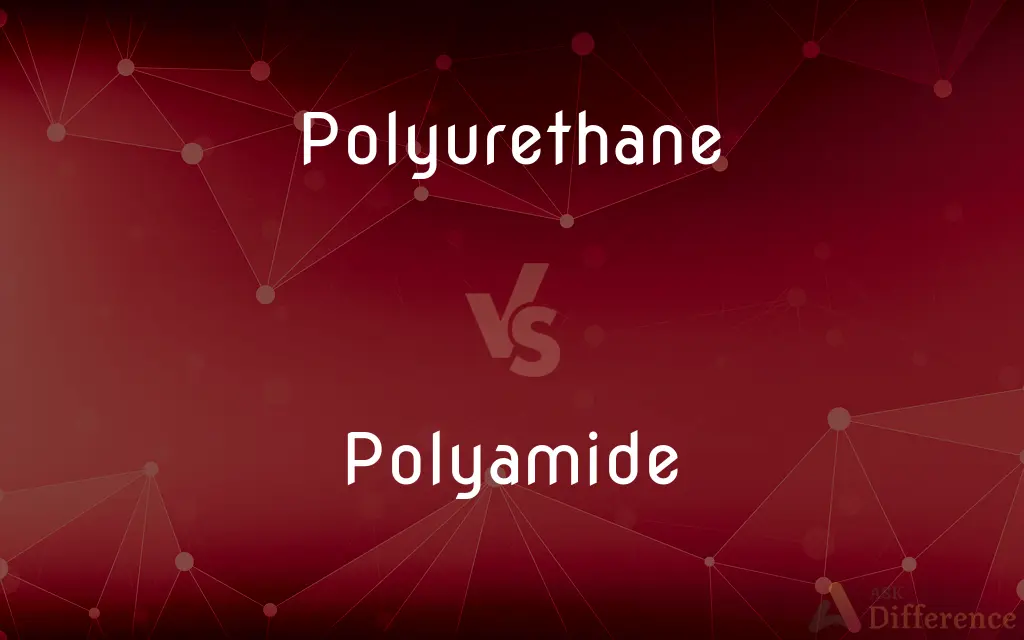Polyurethane vs. Polyamide — What's the Difference?
By Urooj Arif & Maham Liaqat — Updated on February 22, 2024
Polyurethane is versatile with exceptional elasticity and resistance to abrasion, while polyamide, known as nylon, offers superior strength and thermal resistance.

Difference Between Polyurethane and Polyamide
Table of Contents
ADVERTISEMENT
Key Differences
Polyurethane, a polymer composed of organic units joined by carbamate links, is renowned for its flexibility and durability, making it ideal for a wide range of applications from automotive parts to footwear. Polyamide, on the other hand, is characterized by its amide bonds and is widely recognized for its strength, making it a preferred material in the manufacturing of textiles and automotive components.
Polyurethane's exceptional elasticity allows it to be used in products requiring high flexibility, such as foam seating and insulation materials. Polyamide, with its excellent thermal resistance, is better suited for applications that demand high-temperature performance, like engine covers and cooking utensils.
In terms of chemical resistance, polyurethane stands out for its ability to withstand oils, solvents, and various chemicals, making it ideal for coatings and sealants. Polyamide, however, is more susceptible to acids and oxidizing agents, which limits its use in certain chemical environments.
Environmental impact and sustainability are increasingly important considerations. Polyurethane's chemical structure allows for more recyclable options, whereas polyamide's durability and resistance to wear contribute to a longer lifespan, reducing the need for frequent replacements.
Despite their differences, both polyurethane and polyamide play crucial roles in modern manufacturing, offering unique properties that cater to specific industrial and consumer needs, highlighting the importance of material selection in product design and functionality.
ADVERTISEMENT
Comparison Chart
Composition
Organic units joined by carbamate
Amide bonds
Flexibility
High
Lower than polyurethane
Thermal Resistance
Good, but less than polyamide
Superior
Chemical Resistance
Excellent against oils and solvents
Susceptible to acids
Applications
Foam products, sealants, coatings
Textiles, automotive components
Compare with Definitions
Polyurethane
A durable, flexible polymer used in foam, elastomers, and coatings.
The polyurethane foam in the mattress offers comfortable support.
Polyamide
A synthetic polymer, commonly known as nylon, used in textiles.
The polyamide fabric in the backpack resists wear and tear.
Polyurethane
Material known for its resistance to abrasion and impact.
Polyurethane wheels ensure smooth and durable performance on skateboards.
Polyamide
A choice for high-performance gears and bearings.
Polyamide gears provide reliable operation under heavy loads.
Polyurethane
A choice for waterproof and breathable fabrics.
The jacket's polyurethane layer keeps you dry in the rain.
Polyamide
Material used in synthetic fibers for its strength.
The fishing net, made of polyamide, offers excellent durability.
Polyurethane
Used in adhesives due to its strong bonding properties.
The polyurethane adhesive securely bonds the wooden panels.
Polyamide
Used in food packaging for its barrier properties.
Polyamide packaging helps preserve the freshness of food items.
Polyurethane
A synthetic resin used in varnishes and paints.
The table's surface was coated with polyurethane for a glossy finish.
Polyamide
Known for its high melting point, suitable for engineering plastics.
Polyamide parts are used in the engine for their heat resistance.
Polyurethane
Any polymer containing [-NH.CO.O-] linkages; such polymers are much used as the basis of light but rigid foams for packaging (polyurethane foam) and for hard coatings, as on floors.
Polyamide
A polymer containing repeated amide groups, as in various kinds of nylon.
Polyurethane
A synthetic resin in which the polymer units are linked by urethane groups, used chiefly as constituents of paints, varnishes, adhesives, and foams.
Five coats of polyurethane.
Polyurethanes serve a variety of uses.
Polyamide
A synthetic polymer of a type made by the linkage of an amino group of one molecule and a carboxylic acid group of another, including many synthetic fibres such as nylon.
Common Curiosities
Which is more environmentally friendly, polyurethane or polyamide?
Polyurethane offers more recyclable options, but polyamide's durability can lead to a longer product lifespan, reducing environmental impact.
Can polyamide withstand higher temperatures than polyurethane?
Yes, polyamide has superior thermal resistance compared to polyurethane.
Is polyurethane or polyamide better for outdoor applications?
Polyurethane's resistance to abrasion and impact makes it suitable for outdoor applications, but polyamide's thermal resistance and durability are also advantageous.
What makes polyurethane different from polyamide in terms of flexibility?
Polyurethane is generally more flexible than polyamide, making it suitable for products requiring elasticity.
Which is more suitable for automotive components, polyurethane or polyamide?
Both are used in the automotive industry, but the choice depends on the specific application's requirements for flexibility, thermal resistance, and durability.
Are polyurethane and polyamide used in footwear?
Yes, both materials are used in footwear; polyurethane for flexible soles and comfort, and polyamide for durable components like laces and uppers.
Are both polyurethane and polyamide resistant to chemicals?
Polyurethane has excellent resistance to oils and solvents, while polyamide is more susceptible to acids.
Can polyamide be used in high-temperature applications where polyurethane cannot?
Yes, polyamide's superior thermal resistance makes it suitable for high-temperature applications beyond the suitable range for polyurethane.
How do polyurethane and polyamide compare in terms of water resistance?
Polyurethane is generally more water-resistant, making it suitable for waterproof coatings and fabrics, whereas polyamide can absorb more moisture.
Can polyurethane be used in textiles like polyamide?
Polyurethane is used in textiles, mainly for coatings and elastomers, but polyamide is more common in fabric fibers.
How do polyurethane and polyamide impact the environment when disposed of?
Both can impact the environment, but recycling and reuse efforts are improving for polyurethane, while polyamide's durability can reduce the frequency of replacement.
Is polyurethane suitable for medical applications?
Yes, due to its flexibility and biocompatibility, polyurethane is used in various medical devices and implants.
Are polyurethane and polyamide recyclable?
Polyurethane recycling options are expanding, while polyamide recycling is more challenging due to its complex chemical structure.
Can polyurethane and polyamide be used together in composite materials?
Yes, they can be combined in composite materials to leverage the unique properties of both polymers.
How do the costs of polyurethane and polyamide compare?
The cost can vary based on the type and quality of the materials, but polyamide is often more expensive due to its superior thermal and mechanical properties.
Share Your Discovery

Previous Comparison
Intersect vs. Interconnect
Next Comparison
Mia vs. MilAuthor Spotlight
Written by
Urooj ArifUrooj is a skilled content writer at Ask Difference, known for her exceptional ability to simplify complex topics into engaging and informative content. With a passion for research and a flair for clear, concise writing, she consistently delivers articles that resonate with our diverse audience.
Co-written by
Maham Liaqat













































